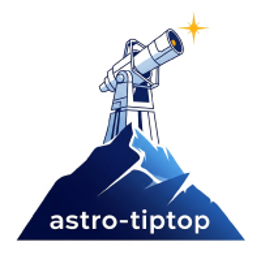Overview

🌌 The big picture
Adaptive optics needs reference sources (natural stars or laser beacons) to measure and correct atmospheric distortions. A set of guide stars used together is an asterism.
👉 In practice, an asterism can be :
- 1 star (mono-NGS) - e.g. ERIS
- 3 stars (multi-NGS) - e.g. MAVIS
TipTop lets you evaluate many candidate asterisms and provides the metrics (SR, FWHM, EE, penalty) you need to rank them for your setup.
🤔 What TipTop adds
Add a single block in your .ini file to drive the exploration:
[ASTERISM_SELECTION]
This section tells TipTop:
- how you provide the asterisms (the mode), and
- the data needed (coordinates, fluxes, or a file with catalogs). Supported modes include:
Sets- you list explicit asterismsSingles1/Singles3- you give a flat star list; TipTop builds all 1-star or 3-star combinations.Generate- synthetic data (dev/tests).File/FileMono- load many fields from a NumPy recarray (.npy) and evaluate each field (triplets vs mono). See all the details and examples in Paramater files - [ASTERISM_SELECTION].
🔁 How it works (at a glance)
- Build candidates from your chosen mode.
- Run AO simulations for each asterism.
- Compute metrics per asterism (and per science target if applicable).
- Rank candidates in your analysis (by a scalar penalty/jitter, lower is better).
- Save outputs for fast reload and post-processing.
For a step-by-step run, see Tutorial - Asterism Seclection.
📦 What you get (outputs)
TipTop writes arrays to outputDir with the simulName prefix:
sr.npy– Strehl ratio per asterism (and per target if multi-target).fw.npy– FWHM [mas] per asterism (and per target).ee.npy– Encircled energy within your radius (or ensquared energy if requested).covs.npy– Covariance ellipse parameters.penalty.npy– scalar ranking metric (aka jitter); lower = better.
Arrays are saved in the global order of evaluation (fields concatenated). They are not pre-sorted.
You can reload all metrics without recomputation via reloadAsterismSelection(...) (see the Running selections page).
💡 Example use cases
- Compare candidate stars around a target (ERIS-like,
Singles1). - Explore triplet combinations over a field (MAVIS-like,
Singles3). - Batch-evaluate catalogue fields (
File/FileMono) and pick the best per field. - Prototype what-if scenarios with synthetic inputs (
Generate).
🔧 Requirements & tips
Your INI must include a valid [ASTERISM_SELECTION] and the LO loop configuration (see sensor/RTC sections).
For File/FileMono, use the documented recarray format; a helper script is provided in the docs to create compatible files.
For analysis, the simulation object returned by asterismSelection is your friend:
simul.cumAstSizes, simul.nfieldsSizes, simul.asterismsInputDataPolar/Cartesian, simul.penalty_Asterism, etc.
✔️ In Summary
[ASTERISM_SELECTION] tells TipTop which stars to try and how to combine them.
TipTop then simulates, scores, and saves metrics so you can rank and choose the best asterism for your AO configuration.